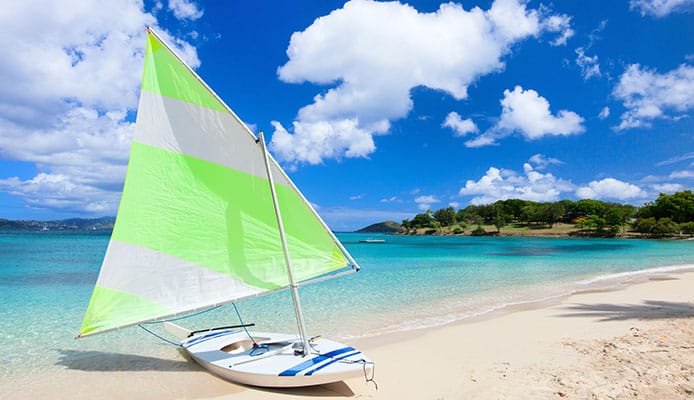
If you’re often tired from paddling and wish for an easier way to move your kayak, perhaps it’s time to invest in a kayak sail. With a good sail kit, you can catch the wind and drift along instead of spending all your energy paddling.
Kayak Sails come in a variety of sizes, shapes, styles, and designs. The abundance of options can make it hard to choose the right one – they all offer something different when it comes to performance.
To make your choice easier, we have created a list of top-rated kayak sail kits that are guaranteed to work great on any kayak. Also, don’t forget to check out the buying guide below if you want to learn how to spot a great kayak sail.
OUR TOP PICK
Advanced Elements
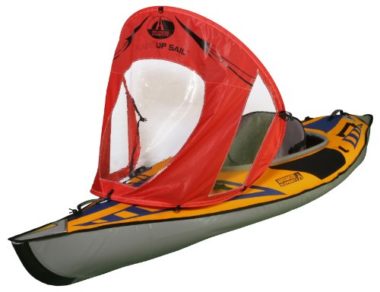
- Stand Out Features - Why We Love It
- Shape fits kayak decks perfectly
- Internal spring frame doesn’t corrode
- Durable rip-stop cloth construction
- Compact package for easier portability
- Three windows for top-level visibility
- Easy to use and easy to install
Material: Rip-stop sail cloth
Weight: 8 ounces
Packed size: 18 inches (diameter)
EDITORS CHOICE
Sea Eagle QuikSail
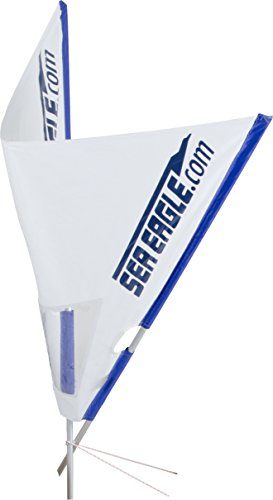
- Stand Out Features - Why We Love It
- Strong aluminum sail frame
- High-quality Neil Pryde sail
- Hands-free sail operation
- Quick and easy setup
- Nylon carry bag included
- Easy to use and easy to set up
Dimensions: 43 x 3 inches (extends up to 81 inches)
Area: 14 square feet
Frame: Aluminum
Weight: 2 pounds
Sail Speed: up to 7 knots
BEST VALUE
Mexidi Foldable Downwind
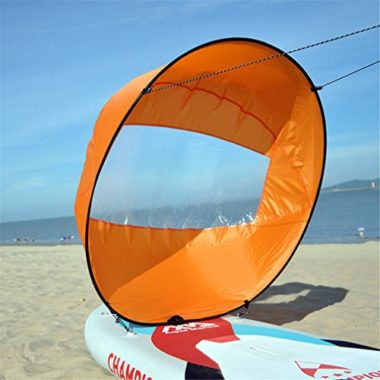
- Stand Out Features - Why We Love It
- Triple-stitched Taffeta guarantees durability
- Wide view window for easier navigation
- Carabiners for securing the sail
- Incredibly compact when packed
- Holds shape even in strong winds
- Easy to install
- Perfect to glide using the power of the wind
Height: 42 inches
Width: 42 inches
Material: Polyester Taffeta, PVC
Weight: 11.4 ounces
Packed size: 15.8 inches (diameter)
Sail Speed: 4 to 13 knots
How To Choose The Best Kayak Sail – Buying Guide
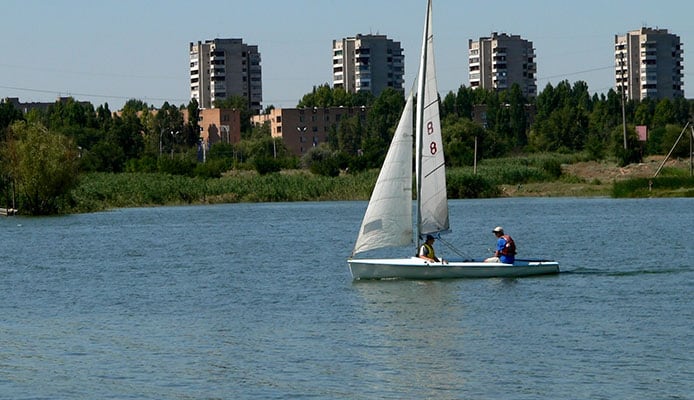
A top-rated kayak sail kit will easily attach to any kayak and help you move with the breeze. It is important for your kayaking safety that you spend the time to find the perfect sail kit. When choosing a sail for kayak, considering factors like size, materials, and ease of use can point you in the right direction.
Type
There are a few different types of sails – circle shape sails, V-shaped sails, and tall L-shaped sails. We’ll briefly explain each one so you can figure out what works best for your kayak.
Circle shape sails: This is the most popular sail design. Circle shape sails are targeted at people who want to learn how to kayak or beginner kayakers. They are easy to install and can turn any kayak into a sailing kayak. They are normally attached with three clamps and can only be positioned in one direction.
V-shaped sails: These sails work best with larger kayaks. Their large size, with the wide V-shaped end at the top, makes it easy for the wind to tip over small kayaks. This sail is the best for cruising downwind and can normally only go in one direction.
Tall L-shaped sails: These sails are best left to the professionals. Once you have experience with circle shape sails and V-shaped sails, you can graduate to using a tall L-shaped sail. These sails require the highest maintenance and you may need to adjust your kayak to suit the sail.
Material
There is a variety of materials used for making a sail. Keep in mind, however, that materials determine how durable your sail is. Also, the type of material can determine how heavy your sail is. Three common types of materials used for kayak sails are plastic, cloth, and carbon fiber.
Plastic: Plastic is perhaps the most common material and will be frequently used for circle shape sails. Plastic is durable, lightweight, and can resist water damage, but it may not last as long as other materials. It is affordable and a great budget option for sailing kayaks beginners. However, more advanced kayakers will find these models insufficient.
Cloth: Cloth is another popular material used in kayak sailing. Cloth can be durable, but its major drawback is that it is heavy when dry and even heavier when wet. You may want a cloth sail with a waterproof coating if you plan on kayak sailing in the rain.
Carbon Fiber: This is the best sail material that you can buy. It’s extremely strong, durable, lightweight, and very resistant to damage. This material can take some wear and tear without breaking.
you might also like :
Width
The width of your sail, or sailing kayak, will determine how well it catches wind. A wider material means a larger surface area for the wind to catch on. You want your sail to be wide enough that you can catch the breeze to cruise along, but not too wide and large that it becomes a tipping risk.
You will have to find the middle ground between widths, which will likely be dependent on the type of sailing kayak you are using. You wouldn’t want the wind to carry your kayak or make it unsafe to use. The perfect sail will be wide enough to safely move you along the surface.
Rocker
The rocker is the hull curvature from a kayak’s bow to stern. You want to have a sailing kayak with a little rocker, but not too much. The rocker can improve maneuverability, but too much can lead to off–tracking.
We advise that you try and find a balance that gives you a mix of maneuverability and stability. This way, using the kayak sail will be a lot easier and you’ll be able to get the most of the propulsion that the wind can give you.
Keel Strip
A keel strip is often an adhesive strip that can be added as a layer of protection to your kayak in areas that are at risk for abrasions. If your kayak does not have a keel strip, you will want to add one. Along with protection from abrasions, keel strips can help with the stability of your kayak.
Rudder
A rudder blade is a kayak accessory that you can add to your kayak for steering. When you use a sail, you shouldn’t have to use your paddle frequently. This means that as you are cruising along, you need something to guide your direction. A rudder blade acts as your kayak’s guidance system.
A rudder can be easily added to the back of your kayak and will have you steering left and right with ease. Beginners may not need it but, if you really enjoy kayak sailing, you will want to invest in a rudder.
Advantages And Disadvantages Of Using A Kayak Sail
While the advantages of using a kayak sail heavily outweigh the disadvantages, it’s worth pointing out that both exist. We’ll try to present both in a few paragraphs, so you can decide whether it’s the right solution for your kayak.
Advantages
The main benefit of adding a sail to your kayak is additional speed on the water. Compared to standard paddling, you’ll be able to reach your destination a lot faster. As a bonus, less paddling means your arms will be less tired, so you’ll be able to stay on the water for a longer time.
If you’re only using wind power to move the kayak, this means that your hands will be completely free. Thanks to this, you can relax and grab a snack or drink while gently sailing. In addition to this, a kayak sail can also be used for trolling when fishing. The wind will move the kayak just like a motor would, so you can cast a bait and wait for the fish to bite.
Disadvantages
Most of the downsides of kayak sails are related to winds that are too strong. This can cause the kayak to lose balance and stability which can be a problem in choppy water. In turn, it will also require more paddling work to compensate for the loss in balance.
While this problem is more significant with larger sails, small sails can also be impacted by it so we advise that you stay careful and avoid using sails (and kayak altogether) in stormy weather. One more issue with a kayak sail is that it doesn’t allow you to perform a roll in the water. If you want to do this, you’ll need to detach the sail first.
Points of Sail
Even though a kayak sail is small, the points of sail are something that every sailor should know. These points apply for any type of sailing and show you the boat position relative to the wind, represented as a clock. Let’s take a quick look at each of them.
No-Go Zone: This is the zone right in front of the boat if you’re facing the wind directly (headwind). Since the sails don’t fill, no sailing is possible.
Close Haul: Right next to the no-go zone is the close haul, where the boat is close to the wind with very tight sails. While the wind pushes the boat, this is counter-balanced by the boat keel.
Close Reach: Even though the wind still hits the beam from the front, it’s moved a bit to the side. This allows you to relax the kayak sails a bit.
Beam Reach: At the beam reach point, the wind hits the boat from the side (crosswind). Even though the boat still heels, the sails can be pretty loose.
Broad Reach: The boat stops heeling in this position, and the wind slowly starts filling the sails. Depending on the wind, it starts picking up speed.
Running: The wind blows behind the boat (tailwind) so you can completely loosen the kayak sails to maximize the speed.
Sailing Skill
When choosing a kayak sail, be sure to consider your sailing skill because some models are a lot easier to control than others. If you’re a total beginner at sailing, we advise that you get a circular sail. This type is pretty straightforward and won’t require a lot of effort or adjustments based on the wind.
On the other hand, if you know a thing or two about points of sail and how to get the most out of it, you should go with a type of sail that gives you more versatility on the water. While it might not necessarily be faster, it will allow you to control the direction a lot better.
FAQs
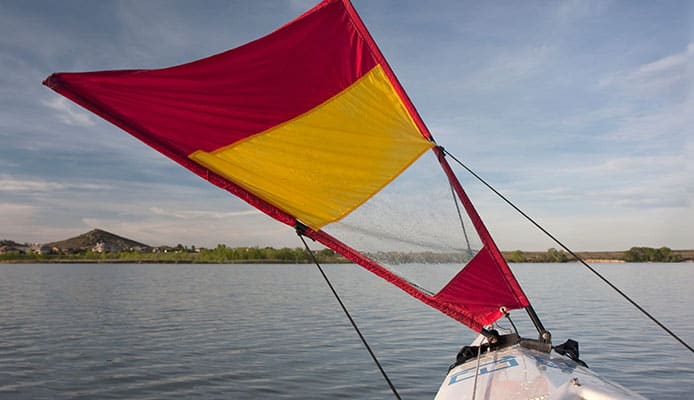
Q: Can You Sail A Kayak?
Yes, you can. Regardless of kayak type, pretty much every kayak can be used for sailing. Most kayak sail kits are universal, so you won’t have a problem securing them to your vessel. A kayak sail will help you save energy and move faster on the water.
Q: Why Use A Sail With A Kayak?
A kayak sail gives you the benefits of speed, convenience, and fun. By using wind power, you can take a break from paddling or pick up speed without tiring your muscles. A short kayaking trip can turn into an all-day-long adventure when you conserve energy using a sail.
Kayaking is a great exercise that gets you active on the water. There are a lot of health benefits of kayaking, but you may want to take a break and just cruise. A kayak with sail allows you to take breaks and rest when you feel tired. It is also incredibly fun to use your kayak in a new way.
Q: Are Kayak Sails Safe?
Yes. However, the best way to ensure that your sail is safe, you should be certain that you are using the correct sail for your kayak and skill. You also want to ensure that your sail is installed properly using the provided user manual or instructions. In addition, you should be certain to still follow all the tips for kayak safety.
For your safety, it is best that you know the area where you are kayaking, know the weather conditions for the day, know all your equipment, and know your own limitations. While kayak sailing is generally safe, following these steps can ensure that you aren’t in any danger, allowing you to relax and have a good time. If you are ocean kayak sailing, be especially aware of the wave and water condition. Waves that are too large or rough water can lead to dangerous situations.
Related Post: Sailing A Kayak
Q: What Are The Advantages Of Using A Sail With A Kayak?
As we mentioned, the major benefit of using a sail is preserving your energy. Most kayakers can only kayak for a few hours at most if they are constantly paddling. However, using a sail saves you energy by cruising with the wind. This means that you could potentially stay out all day on the water (if the weather conditions allow it).
Q: How Do Wind Sails Work?
A wind sail relies on differences in air pressure to move your kayak forward. When you properly adjust the sail, it creates a low-pressure zone in front of it and a high-pressure zone behind it (windward side). When the wind is strong enough, these differences become larger so your kayak starts sailing.
Globo Surf Overview
As you had the chance to see, a kayak sail is an awesome addition to any kayak or canoe. The best kayak sail kit lets you rest between sets of paddling while still moving on the water. Along with conserving energy, sailing kayaks is a lot of fun! With a kayaking sail, you can go faster and spend more time out on the water. Hopefully our guide has helped you figure out what you need, so you can have the perfect sail for your next adventure!


